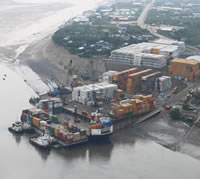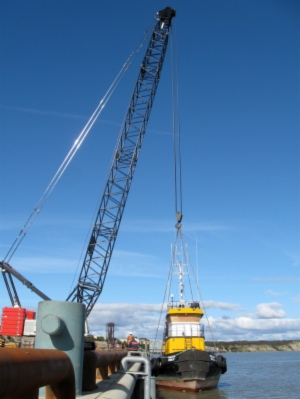Port of Bristol Bay Cargo Dock Upgrade Supports U.S. Salmon Exports, Jobs in Alaska

To keep up with the growing demand for Alaskan salmon domestically and abroad, local leaders at the Bristol Bay Borough in Naknek, Alaska knew significant improvements needed to be made to the Bristol Bay Borough Cargo Dock. As the tenth busiest port in volume and fourth busiest in the value of exports of fish, the Port of Bristol Bay moves over 93 million pounds of processed salmon annually, making it a vital part of Alaska’s southwestern economy. To increase the capacity of the dock and allow companies to expand, these upgrades were crucial. They were also necessary to keep local fisherman and processing crews employed.
After much discussion and consideration, Bristol Bay Borough leaders decided to reach out to officials at the U.S. Economic Development Administration to discuss opportunities for infrastructure funding through EDA’s Public Works program. As the only deep water facility in southwest Alaska that served employers in the commercial fishing industry, the Bristol Bay Borough qualified for EDA investment funds.

New Port of Bristol Bay crane pulling tug boat out of the water at the end of the season.
In 2008, EDA awarded the Bristol Bay Borough $1.7 million to make improvements to the Borough’s cargo dock. Upgrades included installation of a new bull rail, bollards, electrical and lighting, fenders, ladders, and a crushed surface.
In 2009, EDA awarded the Borough another $2.2 million to help with the purchase of a 92,000-pound forklift and a 300-ton crane. The equipment was needed to increase efficiency, safety and capacity in cargo operations.
“Thank you EDA for the investment that has allowed the Port of Bristol Bay to realize its vision,” said Robert “Herk” McDermott, Port Foreman and Harbor Master, Port of Bristol Bay. “We’re meeting the needs of the sockeye salmon capital of the world in a safe productive shipping environment!”
To date, EDA’s investments have helped create 860 jobs, retained 4,600 jobs and resulted in $95 million in private investment. Additionally, Alaska Marine Lines can now leave their tugboats at the Port of Bristol Bay generating more revenue for Alaska’s southwestern economy.
Tags: Infrastructure








